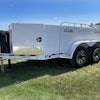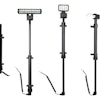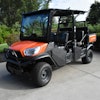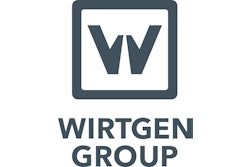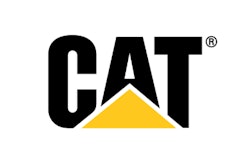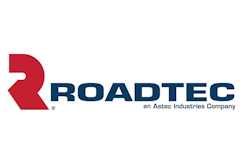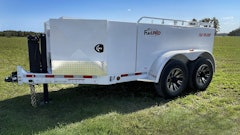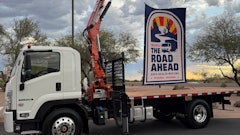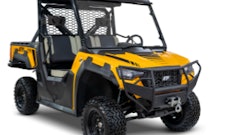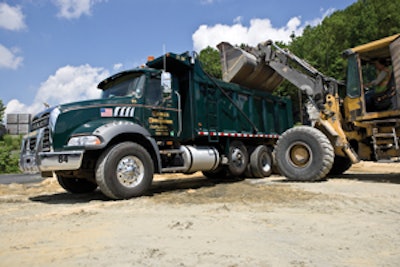
To meet stringent, near-zero emissions standards set by the U.S. Environmental Protection Agency, the vast majority of trucks sold after January 1st will be equipped with Selective Catalytic Reduction (SCR). This technology uses a catalytic system - which includes diesel exhaust fluid (DEF) - to treat exhaust and reduce it into simple nitrogen and water vapor.
"The exhaust coming out of a 2010 heavy-duty diesel engine with an SCR platform has near-zero regulated amounts of exhaust gas," reports David McKenna, director of powertrain sales and marketing, Mack Trucks. "It is hard for us to even measure this stuff in a lab."
The particulate matter emitted is 0.2 grams per brake horsepower hour. (For reference, this is equal to 1/2270th of a pound.) "If you look inside the exhaust stack, there is no soot," says McKenna. "In 2010, we are essentially neutralizing the oxides of nitrogen into simple nitrogen (N2) and water vapor (H2O). It is almost immeasurable amounts of other gasses that are coming out. It is an ultra-clean engine."
SCR technology requires virtually no changes to existing base engines. However, the material used in the catalytic converter is expensive, which adds to the initial purchase price. For instance, let's look at the offerings from Daimler Trucks and Mack Trucks.
Emissions technology surcharges for Freightliner trucks equipped with Detroit Diesel DD15 and DD16 big bore engines, as well as the medium bore DD13, will be $9,000 per vehicle. A surcharge of $7,300 will be added to vehicles equipped with the Cummins ISC8.3 engine, and a $6,700 surcharge will be added to the price of vehicles equipped with Cummins ISB6.7 engines.
The price increases at Mack are very similar. "We are going to be in the $9,600 range for conventional [Class 8 trucks] and around $10,000 for the TerraPro cabover [truck]," says McKenna.
Despite these initial purchase price increases, the long-term performance gains promise a return on this investment. "SCR is the only emissions technology in decades proven to be as good for business as it is for the environment," says Mark Lampert, senior vice president of sales, Daimler Trucks North America. "We are pleased to deliver a proven solution that gives our customers a return on their emissions technology investment."
Payback in fuel savings
According to Daimler Trucks, SCR treats NOx emissions downstream in the exhaust so that the engine can be tuned to run more efficiently and economically. "SCR is the only technology that will provide significant fuel savings to our customers," Lampert asserts.
"Any time you purchase diesel fuel, you are going to see an immediate payback," McKenna asserts. "Are you going to see the payback to the degree you would with the volumes of fuel a highway truck goes through vs. a vocational truck? No, but the interesting takeaway with SCR technology is that the harder you work the engine, the better the fuel economy is relative to the same engine with the same duty cycle of 2007 to 2010."
He explains, "With a typical vocational truck, you need a lot of power (high torque) at very low [engine speed], which can mean a lot of NOx production. If we can neutralize the NOx after the fact, that allows us to dramatically improve the fuel economy and still dose well below the 3% rate we've claimed for diesel exhaust fluids." Consequently, the fuel economy improvement on a percentage basis is actually better than that of a highway truck.
"One of the by-products of allowing the engine to breathe a little better instead of choking it off with massive rates of EGR is the soot loading of the lube oil from the combustion is much less," McKenna notes. "You are not getting the soot loading on the cylinder walls that you had yesterday. We have actually lowered the rate of exhaust gas recycling, allowing more oxygen in the cylinder so we are getting more thorough combustion. So you are not getting the soot deposits that the industry was having historically with higher rates of EGR."
From an operating perspective, Lambert states, the fuel efficiencies achieved with the Detroit Diesel DD15 engine with BlueTec emissions technology effectively return North American trucking to pre-EGR levels, while reducing dependence on foreign oil and bringing emissions to near-zero levels at the tailpipe. "We feel strongly that providing our customers with payback in the form of significant improvement in fuel economy is of fundamental importance and an appropriate return on their investment in 2010 technology," he adds.
The downside is the weight penalty due to the additional components and fluid. "We are clearly communicating the weights, including the DEF tank and DEF," says McKenna. "We have to remember that DEF is relatively dense. It is almost 10 lbs./gal., so the installed full DEF weight is anywhere between 400 and 465 lbs. We are also now looking at some smaller DEF tanks and improved packaging arrangements that will be introduced with Phase 2 start of production."
Clearing common misconceptions
To set the record straight, DEF is not a dangerous material. "DEF is 32% Urea and 68% deionized water," says McKenna.
And while there will be an additional expense associated with filling the DEF tank, the consumption rate of DEF to diesel is only about 3%. "Let's say you have a vocational vehicle that goes through 50 gal. of fuel in a shift. That is a consumption of between 1.2 and 1.5 gal. of DEF," McKenna points out. "If you get a 7- or 8-gal. DEF tank, that is going to last you more than a week. You can't physically drive far enough to go through 7 gal. of DEF in a 24-hour day."
Cold weather performance is also a concern circulating around the industry. "We know that DEF will freeze below 12° F. After all, it is 68% deionized water," McKenna comments. DEF freezes into a slush-like material, then returns to a fluid once the temperature goes above 12° F.
"When it is on the truck, we have a system in place that will pump engine coolant through the DEF tank to keep it at about 60° F," says McKenna. When you turn the key off on a Mack U.S. 2010 truck, the DEF product pump continues to run. "It pumps the product all the way from the injector back into the tank, so you have no frozen lines."
Even if you start the truck before the DEF thaws, emissions aren't an issue. "A cold engine produces near-zero NOx to start with," McKenna explains.
Proof of performance
The H&K Group is a family of vertically integrated companies serving the contracting and construction industries, with over 80 locations throughout eastern Pennsylvania, New Jersey, Maryland and Delaware. It is one of the Mid-Atlantic Region's largest construction materials and full-service site contracting companies.
According to Dan Alderfer, fleet superintendent, the company has more than 1,200 licensed vehicles. "There are 13 truck shops where we do the maintenance, and I do the purchasing of the vehicles," he says.
The H&K Group took delivery of a 2010 Mack Granite test truck in April of 2008. It is used to haul asphalt and stone to jobsites. As of Spring 2009, the truck had racked up around 50,000 trouble-free miles. "It works every single day," says Alderfer. "We have actually had a very good experience."
The company initially had reservations about the SCR technology. "We were worried about it," Alderfer admits. "You hear a lot of things. You hear about the [DEF] freezing. We actually haven't seen any problems with it."
The H&K Group has kept a close watch on the truck's performance. On average, Alderfer estimates they have seen around a 1-mpg improvement in fuel economy. "It is doing well," he states.
Handling of the DEF hasn't posed any significant challenges. "We have it on a mobile cart we keep back in the oil room with the other drums," says Alderfer. "There is no special consideration. It is safe."
DEF consumption is minimal. "We are trying to keep real close records, so we fill the truck once a week. I have seen it take as little as 3.5 gal. and as much as 8 gal. a week," says Alderfer. "Typically, it is a little less than 4 gal. per 1,000 miles. With the size of tank we have, you could probably take it out two or three weeks, depending upon how many miles you put on the truck."
Regenerations of the catalytic system have been seamless. "You don't even know when it regenerates," says Alderfer. "It just takes care of itself."
He also comments on how clean the exhaust system has remained. "It is just amazing how clean the exhaust is," he says. "There are a little over 50,000 miles on the truck and the stack looks like it is brand new."
Although just one example, if The H&K Group's experience with 2010 SCR technology is at all representative of the average vocational truck, the 2010 emissions regulations could turn out to be a non-event, with the exception of the initial purchase price. The good news is, for the first time is several years, the added cost may be recouped long term through increased performance and fuel economy.

